Assessing Spatial Flood Vulnerability at Kalapara Upazila in Bangladesh Using an Analytic Hierarchy Process
Abstract
1. Introduction
2. Materials and Methods
2.1. Study Area
2.2. Method Overview
2.3. Datasets and Sources
2.4. Vulnerability Evaluation Criteria, Alternatives and Mapping
2.4.1. Criteria for Physical Vulnerability Mapping
2.4.2. Criteria for Social Vulnerability Mapping
2.4.3. Criteria for Coping Capacity Mapping
2.5. Alternative Ranking and Standardisation Criterion Layer
2.6. Weighting the Criteria Using AHP
2.7. Vulnerability Assessment
2.8. Validation of Vulnerability Assessment
3. Results and Discussion
3.1. Physical Vulnerability Mapping
3.2. Social Vulnerability Mapping
3.3. Coping Capacity Mapping
3.4. Vulnerability without Integrated Coping Capacity
3.5. Vulnerability with Integrated Coping Capacity
3.6. Validation of Vulnerability Assessment
4. Conclusions
Author Contributions
Funding
Acknowledgments
Conflicts of Interest
References
- Wang, Y.; Li, Z.; Tang, Z.; Zeng, G. A GIS-based spatial multi-criteria approach for flood risk assessment in the Dongting Lake Region, Hunan, Central China. Water Resour. Manag. 2011, 25, 3465–3484. [Google Scholar] [CrossRef]
- Fernandez, P.; Mourato, S.; Moreira, M. Social vulnerability assessment of flood risk using GIS-based multicriteria decision analysis. A case study of Vila Nova de Gaia (Portugal). Geomat. Nat. Hazards Risk 2016, 7, 1367–1389. [Google Scholar] [CrossRef]
- Mojaddadi, H.; Pradhan, B.; Nampak, H.; Ahmad, N.; bin Ghazali, A.H. Ensemble machine-learning-based geospatial approach for flood risk assessment using multi-sensor remote-sensing data and GIS. Geomat. Nat. Hazards Risk 2017, 8, 1080–1102. [Google Scholar] [CrossRef]
- Wahlstrom, M.; Guha-Sapir, D. The Human Cost of Weather-Related Disasters 1995–2015; UNISDR: Geneva, Switzerland, 2015. [Google Scholar]
- Chen, H.; Ito, Y.; Sawamukai, M.; Tokunaga, T. Flood hazard assessment in the Kujukuri Plain of Chiba Prefecture, Japan, based on GIS and multicriteria decision analysis. Nat. Hazards. 2015, 78, 105–120. [Google Scholar] [CrossRef]
- Xenarios, S.; Nemes, A.; Sarker, G.W.; Sekhar, N.U. Assessing vulnerability to climate change: Are communities in flood-prone areas in Bangladesh more vulnerable than those in drought-prone areas? Water Res. Rural Dev. 2016, 7, 1–19. [Google Scholar] [CrossRef]
- Ntajal, J.; Lamptey, B.L.; Mahamadou, I.B.; Nyarko, B.K. Flood disaster risk mapping in the Lower Mono River Basin in Togo, West Africa. Int. J. Disas. Risk Reduct. 2017, 23, 93–103. [Google Scholar] [CrossRef]
- Fang, Y.; Yin, J.; Wu, B. Flooding risk assessment of coastal tourist attractions affected by sea level rise and storm surge: A case study in Zhejiang Province, China. Nat. Hazards 2016, 84, 611–624. [Google Scholar] [CrossRef]
- Dewan, A.M. Hazards, Risk, and Vulnerability. In Floods in a Megacity; Springer: Dordrecht, The Netherlands, 2013; pp. 35–74. [Google Scholar] [CrossRef]
- Lee, S.; Kim, J.-C.; Jung, H.-S.; Lee, M.J.; Lee, S. Spatial prediction of flood susceptibility using random-forest and boosted-tree models in Seoul metropolitan city, Korea. Geomat. Nat. Hazards Risk 2017, 8, 1185–1203. [Google Scholar] [CrossRef]
- Foudi, S.; Osés-Eraso, N.; Tamayo, I. Integrated spatial flood risk assessment: The case of Zaragoza. Land Use Policy 2015, 42, 278–292. [Google Scholar] [CrossRef]
- Eckert, S.; Jelinek, R.; Zeug, G.; Krausmann, E. Remote sensing-based assessment of tsunami vulnerability and risk in Alexandria, Egypt. Appl. Geog. 2012, 32, 714–723. [Google Scholar] [CrossRef]
- Rashid, A.K.M.M. Understanding Vulnerability and Risks. In Disaster Risk Reduction Approaches in Bangladesh; Shaw, R., Mallick, F., Islam, A., Eds.; Springer: Tokyo, Japan, 2013; pp. 23–43. [Google Scholar] [CrossRef]
- Turner, B.L.; Kasperson, R.E.; Matson, P.A.; McCarthy, J.J.; Corell, R.W.; Christensen, L.; Eckley, N.; Kasperson, J.X.; Luers, A.; Martello, M.L. A framework for vulnerability analysis in sustainability science. Proc. Natl. Acad. Sci. USA 2003, 100, 8074–8079. [Google Scholar] [CrossRef]
- Dewan, A.M. Vulnerability and Risk Assessment. In Floods in a Megacity; Springer: Dordrecht, The Netherlands, 2013; pp. 139–177. [Google Scholar]
- Birkmann, E.J. Measuring Vulnerability to Natural Hazards: Toward Disaster Resilient Societies; United Nations University Press: Tokyo, Japan, 2006. [Google Scholar]
- Hoque, M.A.-A.; Phinn, S.; Roelfsema, C.; Childs, I. Assessing tropical cyclone risks using geospatial techniques. Appl. Geog. 2018, 98, 22–33. [Google Scholar] [CrossRef]
- Rimba, A.B.; Setiawati, M.D.; Sambah, A.B.; Miura, F. Physical Flood Vulnerability Mapping Applying Geospatial Techniques in Okazaki City, Aichi Prefecture, Japan. Urb. Sci. 2017, 1, 7. [Google Scholar] [CrossRef]
- Roy, D.C.; Blaschke, T. Spatial vulnerability assessment of floods in the coastal regions of Bangladesh. Geomat. Nat. Hazards Risk 2015, 6, 21–44. [Google Scholar] [CrossRef]
- Bhuiyan, S.R.; Baky, A.A. Digital elevation based flood hazard and vulnerability study at various return periods in Sirajganj Sadar Upazila, Bangladesh. Int. J. Disas. Risk Reduct. 2014, 10, 48–58. [Google Scholar] [CrossRef]
- Cozannet, G.L.; Garcin, M.; Bulteau, T.; Mirgon, C.; Yates, M.; Méndez, M.; Baills, A.; Idier, D.; Oliveros, C. An AHP-derived method for mapping the physical vulnerability of coastal areas at regional scales. Nat. Hazards Earth Syst. Sci. 2013, 13, 1209–1227. [Google Scholar] [CrossRef]
- Sanyal, J.; Lu, X. Remote sensing and GIS-based flood vulnerability assessment of human settlements: A case study of Gangetic West Bengal, India. Hydrol. Proc. 2005, 19, 3699–3716. [Google Scholar] [CrossRef]
- Kourgialas, N.N.; Karatzas, G.P. Flood management and a GIS modelling method to assess flood-hazard areas—A case study. Hydrol. Sci. J. 2011, 56, 212–225. [Google Scholar] [CrossRef]
- Birkmann, J. Risk and vulnerability indicators at different scales: Applicability, usefulness and policy implications. Environ. Hazards 2007, 7, 20–31. [Google Scholar] [CrossRef]
- Fekete, A.; Damm, M.; Birkmann, J. Scales as a challenge for vulnerability assessment. Nat. Hazards 2010, 55, 729–747. [Google Scholar] [CrossRef]
- Bhuiyan, M.J.A.N.; Dutta, D. Analysis of flood vulnerability and assessment of the impacts in coastal zones of Bangladesh due to potential sea-level rise. Nat. Hazards 2012, 61, 729–743. [Google Scholar] [CrossRef]
- Cutter, S.L.; Barnes, L.; Berry, M.; Burton, C.; Evans, E.; Tate, E.; Webb, J. A place-based model for understanding community resilience to natural disasters. Glob. Environ. Chang. 2008, 18, 598–606. [Google Scholar] [CrossRef]
- Rana, I.A.; Routray, J.K. Integrated methodology for flood risk assessment and application in urban communities of Pakistan. Nat. Hazards 2018, 91, 239–266. [Google Scholar] [CrossRef]
- Ahamed, S.; Rahman, M.M.; Faisal, M.A. Reducing cyclone impacts in the coastal areas of Bangladesh: A case study of Kalapara Upazila. J. Bangladesh Inst. Plan. 2012, 2075, 9363. [Google Scholar]
- Masood, M.; Takeuchi, K. Assessment of flood hazard, vulnerability and risk of mid-eastern Dhaka using DEM and 1D hydrodynamic model. Nat. Hazards 2012, 61, 757–770. [Google Scholar] [CrossRef]
- Hoque, M.A.-A.; Phinn, S.; Roelfsema, C.; Childs, I. Modelling tropical cyclone risks for present and future climate change scenarios using geospatial techniques. Int. J. Dig. Earth 2018, 11, 246–263. [Google Scholar] [CrossRef]
- Hoque, M.A.-A.; Phinn, S.; Roelfsema, C.; Childs, I. Tropical cyclone disaster management using remote sensing and spatial analysis: A review. Int. J. Disas. Risk Reduct. 2017, 22, 345–354. [Google Scholar] [CrossRef]
- Biswas, A.; Zaman, A.M.; Sattar, M.A.; Islam, M.S.; Hossain, M.A.; Faisal, M. Assessment of disaster impact on the health of women and children. J. Health Environ. Res. 2015, 1, 19–28. [Google Scholar]
- Stefanidis, S.; Stathis, D. Assessment of flood hazard based on natural and anthropogenic factors using analytic hierarchy process (AHP). Nat. Hazards 2013, 68, 569–585. [Google Scholar] [CrossRef]
- Roy, P.S. Flood risk assessment using multi-criteria analysis: A case study from Kopili River Basin, Assam, India. Geomat. Nat. Hazards Risk 2018, 9, 79–93. [Google Scholar]
- Kumar, P.; Singh, B.K.; Rani, M. An Efficient Hybrid Classification Approach for Land Use/Land Cover Analysis in a Semi-Desert Area Using ETM+ and LISS-III Sensor. IEEE Sens. J. 2013, 13, 2161–2165. [Google Scholar] [CrossRef]
- Hoque, M.A.-A.; Phinn, S.; Roelfsema, C.; Childs, I. Assessing tropical cyclone impacts using object-based moderate spatial resolution image analysis: A case study in Bangladesh. Int. J. Remote Sens. 2016, 37, 5320–5343. [Google Scholar] [CrossRef]
- Jensen, J.R. Introductory Digital Image Processing: A Remote Sensing Perspective; Prentice-Hall Inc.: Upper Saddle River, NJ, USA, 2005. [Google Scholar]
- Hu, S.; Cheng, X.; Zhou, D.; Zhang, H. GIS-based flood risk assessment in suburban areas: A case study of the Fangshan District, Beijing. Nat. Hazards 2017, 87, 1525–1543. [Google Scholar] [CrossRef]
- Lewis, M.; Bates, P.; Horsburgh, K.; Neal, J.; Schumann, G. A storm surge inundation model of the northern Bay of Bengal using publicly available data. Royal Meteor. Soc. 2013, 139, 358–369. [Google Scholar] [CrossRef]
- Gallant, J.; Read, A.; Dowling, T. Removal of tree offsets from SRTM and other digital surface models. Int. Arch. Photogramm. Remote Sens. Spat. Inform. Sci. 2012, 39, 275–280. [Google Scholar] [CrossRef]
- Oliver, M.A.; Webster, R. Kriging: A method of interpolation for geographical information systems. Int. J. Geograph. Inform. Syst. 1990, 4, 313–332. [Google Scholar] [CrossRef]
- Cutter, S.L.; Boruff, B.J.; Shirley, W.L. Social vulnerability to environmental hazards. Soc. Sci. Quart. 2003, 84, 242–261. [Google Scholar] [CrossRef]
- Neumayer, E.; Plümper, T. The gendered nature of natural disasters: The impact of catastrophic events on the gender gap in life expectancy, 1981–2002. Annal. Assoc. Am. Geograph. 2007, 97, 551–566. [Google Scholar] [CrossRef]
- Radhakrishnan, M.; Nguyen, H.Q.; Gersonius, B.; Pathirana, A.; Vinh, K.Q.; Ashley, R.M.; Zevenbergen, C. Coping capacities for improving adaptation pathways for flood protection in Can Tho, Vietnam. Clim. Chang. 2017, 1–13. [Google Scholar] [CrossRef]
- Solín, Ľ.; Madajová, M.S.; Michaleje, L. Vulnerability assessment of households and its possible reflection in flood risk management: The case of the upper Myjava basin, Slovakia. Int. J. Disas. Risk Reduct. 2018, 28, 640–652. [Google Scholar] [CrossRef]
- Saaty, T.L. Decision making with the analytic hierarchy process. Int. J. Serv. Sci. 2008, 1, 83–98. [Google Scholar] [CrossRef]
- Malczewski, J. Multiple Criteria Decision Analysis and Geographic Information Systems. In Trends in Multiple Criteria Decision Analysis; Ehrgott, M., Figueira, J.R., Greco, S., Eds.; Springer: New York, NY, USA, 2010; Volume 142, pp. 369–395. [Google Scholar]
- Mahapatra, M.; Ramakrishnan, R.; Rajawat, A.S. Coastal vulnerability assessment using analytical hierarchical process for South Gujarat coast, India. Nat. Hazards 2015, 76, 139–159. [Google Scholar] [CrossRef]
- Baeza, C.; Lantada, N.; Amorim, S. Statistical and spatial analysis of landslide susceptibility maps with different classification systems. Environ. Earth Sci. 2016, 75, 1318. [Google Scholar] [CrossRef]
- Tehrany, M.S.; Pradhan, B.; Jebur, M.N. Flood susceptibility mapping using a novel ensemble weights-of-evidence and support vector machine models in GIS. J. Hydrol. 2014, 512, 332–343. [Google Scholar] [CrossRef]
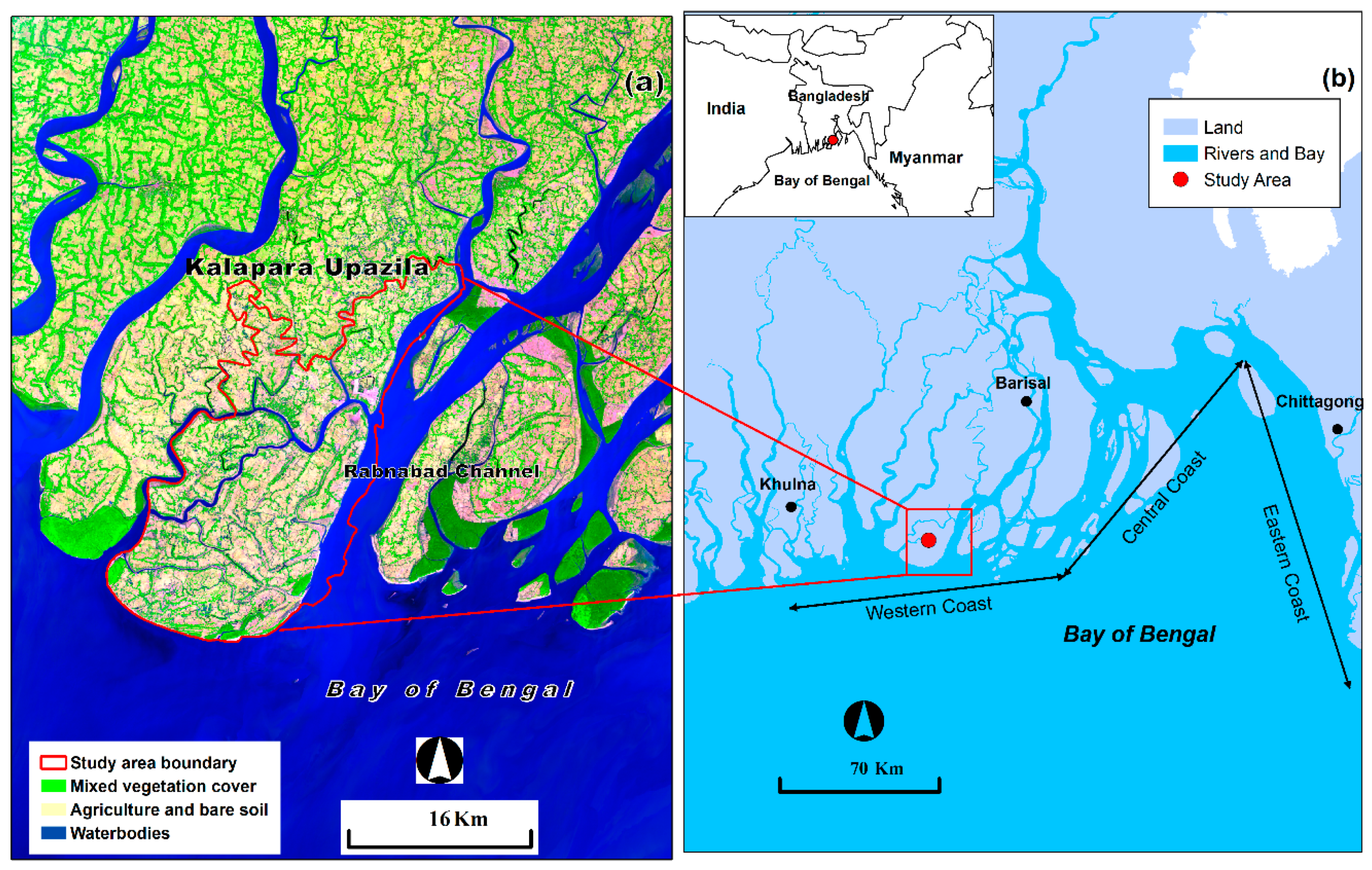

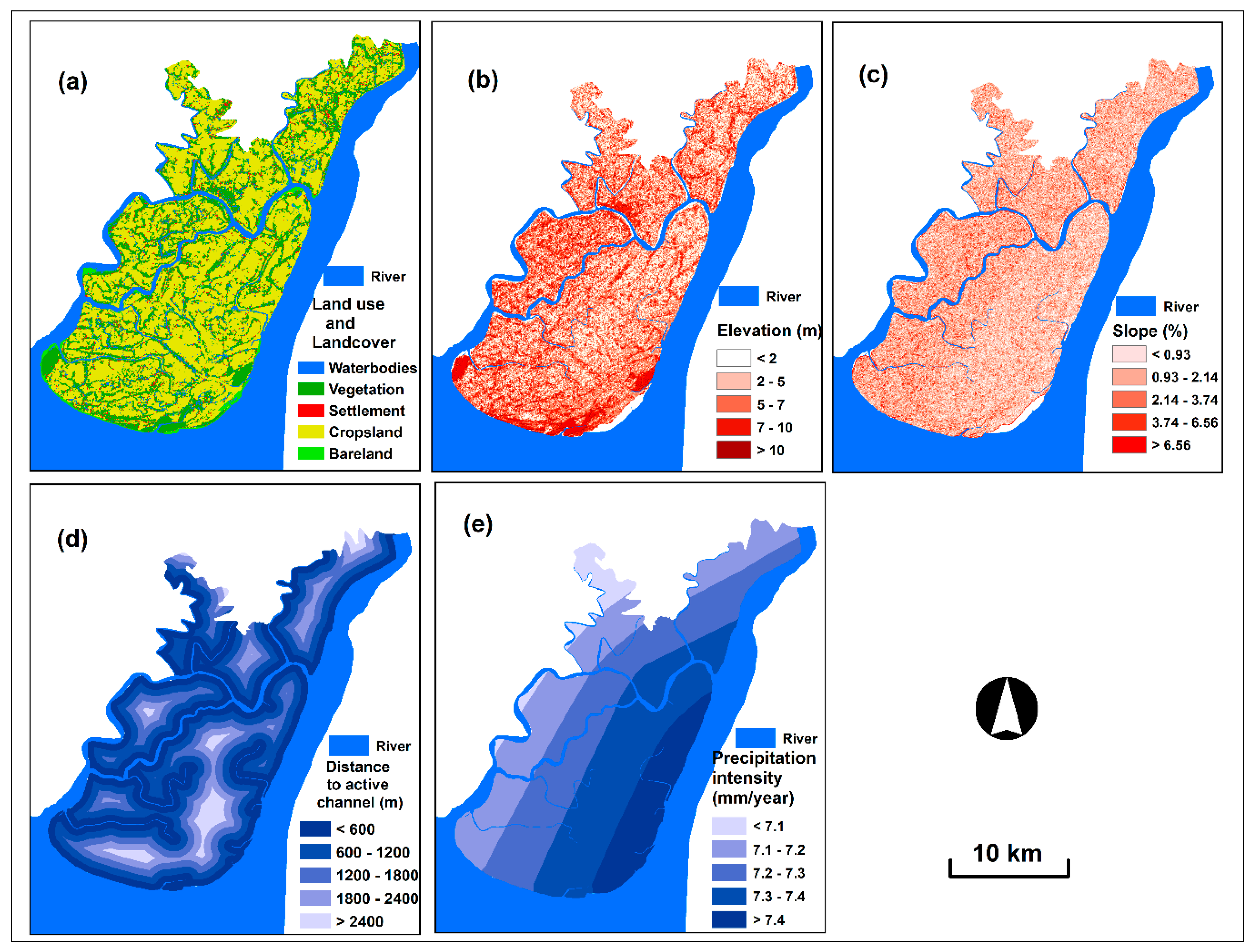
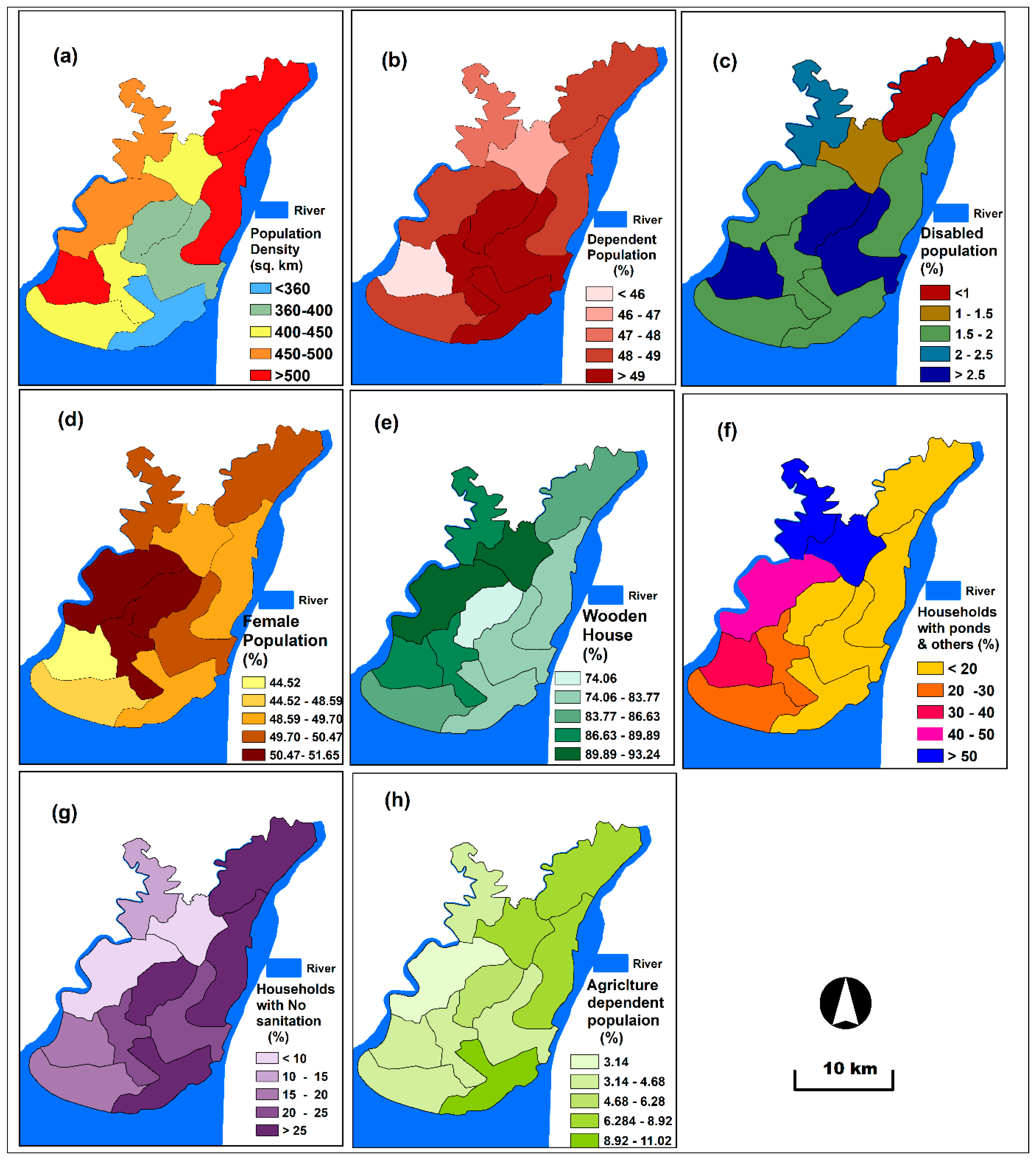
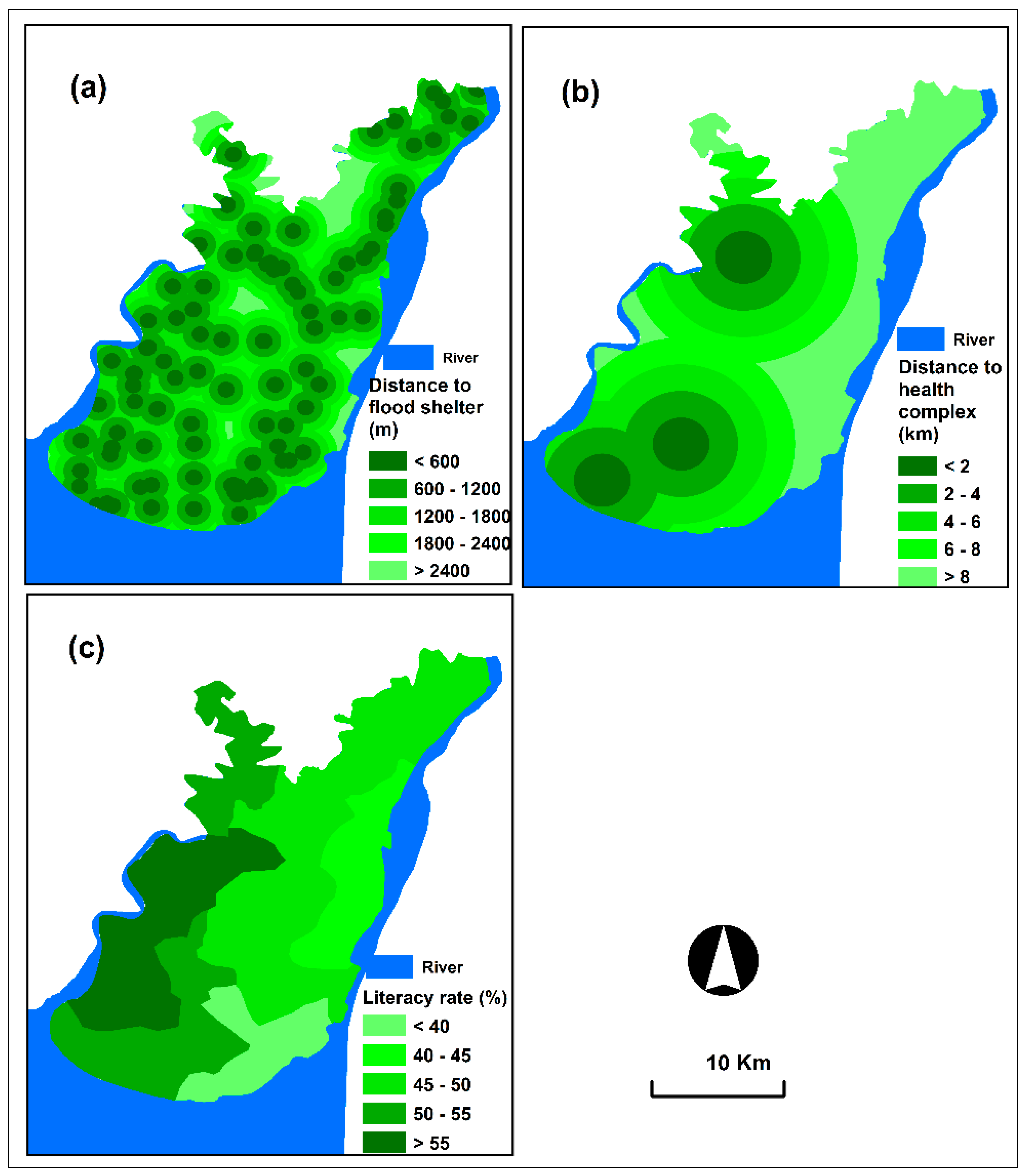
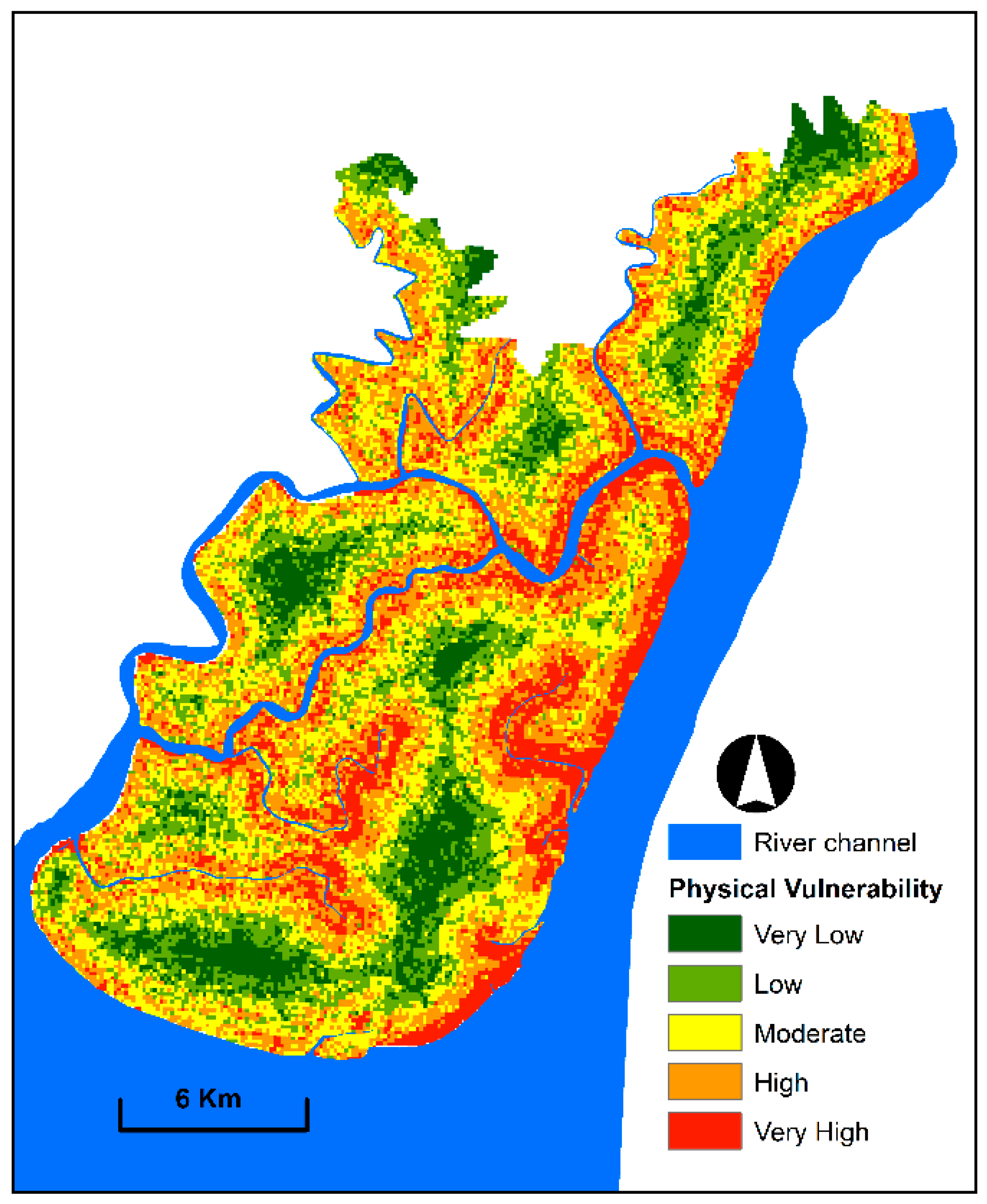

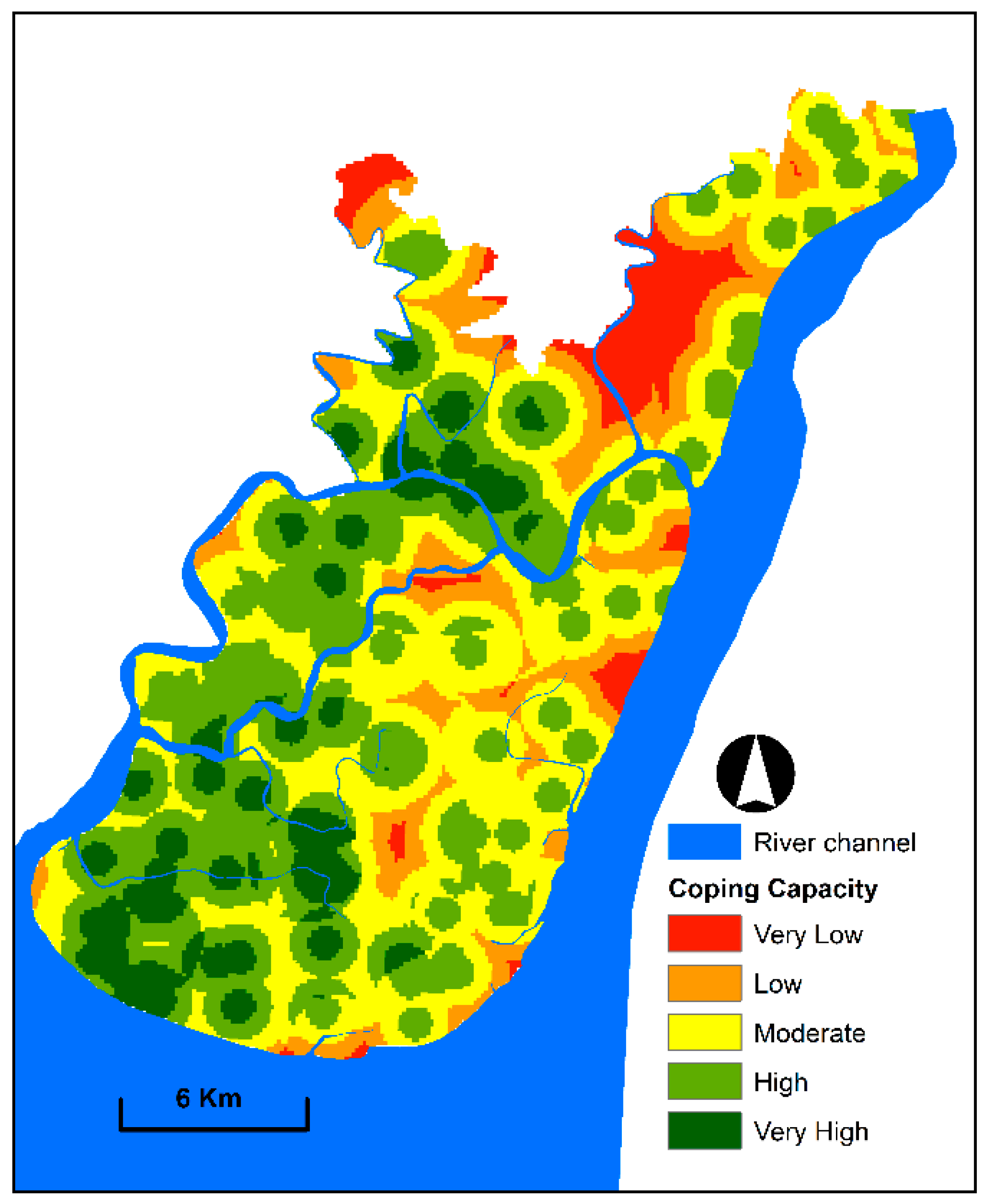
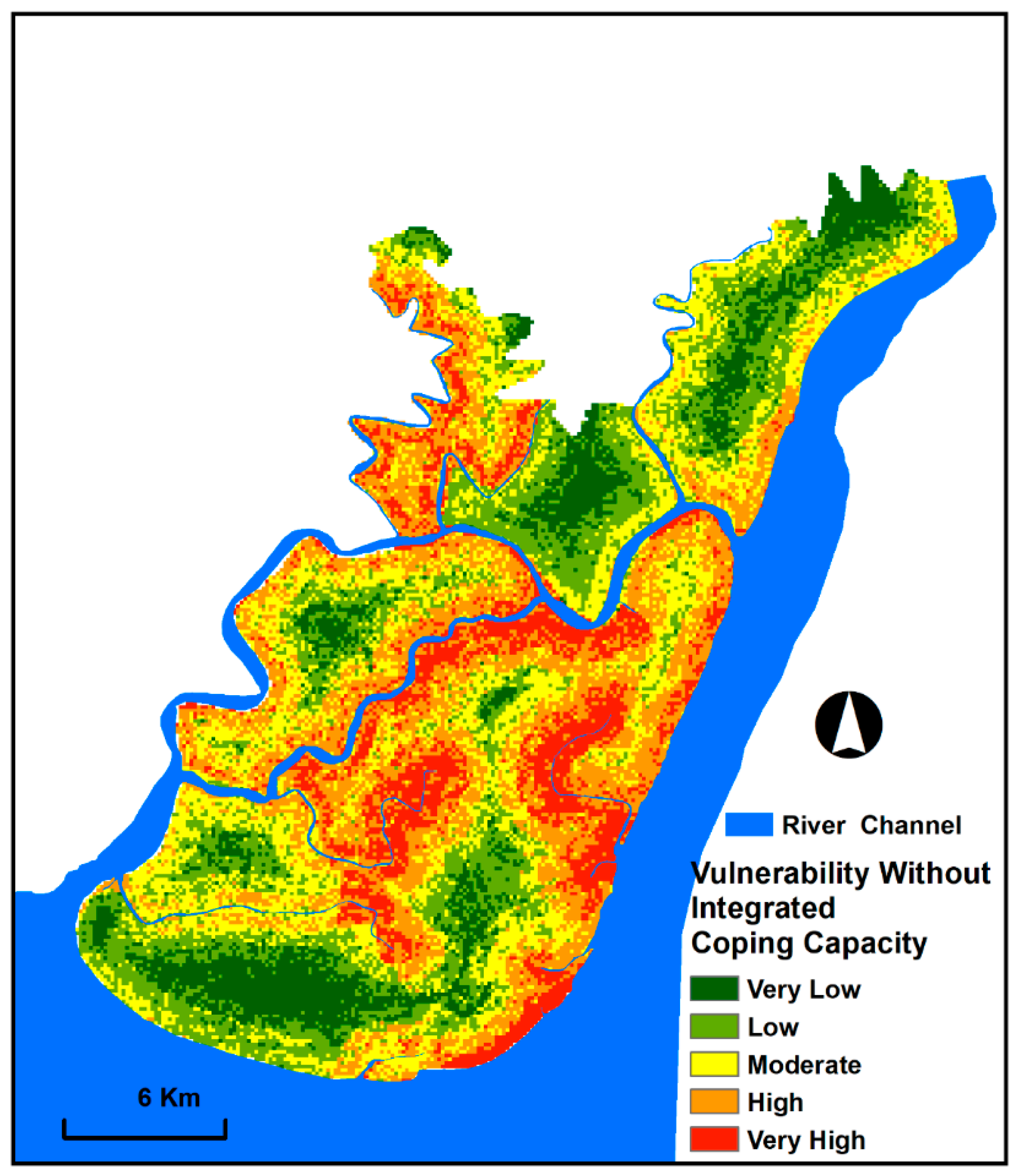
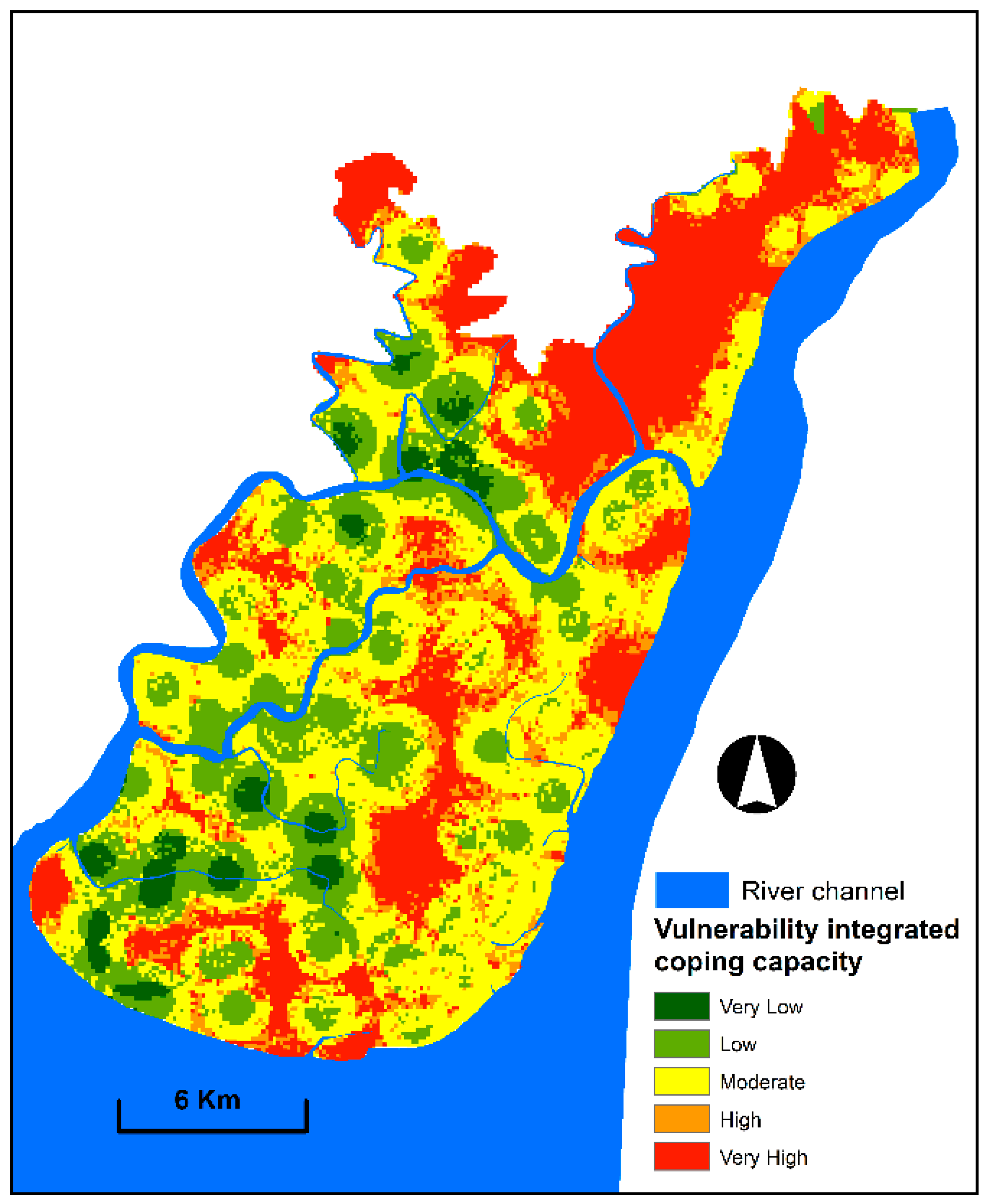
| Data Type | Source | Period | Mapping Output |
|---|---|---|---|
| Landsat 8 OLI | United States Geological Survey (USGS) Earth Explorer | 20-01-2018 | Land use and cover |
| SRTM-DEM (30 m resolution) | USGS Earth Explorer | 11-2-2000 | Elevation and slope |
| River channel | USGS Earth Explorer | 20-01-2018 | Distance to active channel |
| Precipitation | Bangladesh Meteorological Department (BMD) | 2004–2014 | Precipitation |
| Population | Bangladesh Bureau of Statistics (BBS) | Population census of 2011 | Population density, dependent population, female population, literacy rate |
| Wooden house | BBS | Population census of 2011 | Wooden house |
| Household with pond and others | BBS | Population census of 2011 | Household with pond and others |
| Household with no sanitation | BBS | Population census of 2011 | Household with no sanitation |
| Flood shelter and health complex | Fieldwork | August–October | Distance to flood shelter and health complex |
| Component | Criteria | Ranking (Based on Vulnerability) | ||||
|---|---|---|---|---|---|---|
| Very Low (1) | Low (2) | Moderate (3) | High (4) | Very High (5) | ||
| Physical vulnerability | Elevation (m) | >10 | 7–10 | 5–7 | 2–5 | <2 |
| Slope (%) | >6.56 | 3.74–6.56 | 2.14–3.74 | 0.93–2.14 | <0.93 | |
| Precipitation (mm/year) | <7.1 | 7.1–7.2 | 7.2–7.3 | 7.3–7.4 | >7.4 | |
| Land use and cover | Open water bodies | Bare land | Vegetation | Cropland | Settlement | |
| Distance to active channel (m) | >2400 | 1800–2400 | 1200–1800 | 600–1200 | <600 | |
| Social vulnerability | Population density (km2) | <360 | 360–400 | 400–450 | 450–500 | >500 |
| Dependent population (%) | <46 | 46–47 | 47–48 | 48–49 | >49 | |
| Disabled population (%) | <1 | 1–1.5 | 1.5–2 | 2–2.5 | >2.5 | |
| Female population (%) | 44.5 | 44.5–48.5 | 48.59–49.7 | 49.7–50.4 | >50.4 | |
| Wooden house (%) | 74.0 | 74.0–83.7 | 83.7–86.6 | 86.6–89.8 | >89.8 | |
| Household with ponds and others (%) | <20 | 20–30 | 30–40 | 40–50 | >50 | |
| Household with no sanitation (%) | <10 | 10–15 | 15–20 | 20–25 | >25 | |
| Agriculture-dependent population (%) | 3.15 | 3.14–4.68 | 4.68–6.28 | 6.28–8.92 | >8.92 | |
| Coping capacity | Literacy rate (%) | >55 | 50–55 | 45–50 | 40–45 | <40 |
| Distance to flood shelter (m) | <600 | 600–1200 | 1200–1800 | 1800–2400 | >2400 | |
| Distance to health complex (km) | <2 | 2–4 | 4–6 | 6–8 | >8 | |
| Relative Importance | Definition | Description |
|---|---|---|
| 1 | Equal importance | Two factors equally influence the objective |
| 3 | Moderate importance | Experience and judgment slightly favour one factor over another |
| 5 | Strong importance | Experience and judgment strongly favour one factor over another |
| 7 | Very strong importance | One decision factor is strongly favoured over another, and its supremacy is established in practice |
| 9 | Extreme importance | The evidence favouring one decision factor over another is of the highest possible orders of validity |
| 2, 4, 6 and 8 | Intermediate values between adjacent judgement | When compromise is required |
| Component | Criteria | Weight |
|---|---|---|
| Physical vulnerability | Elevation | 0.22 |
| Slope | 0.16 | |
| LULC | 0.08 | |
| Precipitation | 0.12 | |
| Distance from active channel | 0.42 | |
| CR: 0.04 | ||
| Social vulnerability | Population density | 0.11 |
| Dependent population | 0.17 | |
| Female population | 0.17 | |
| Wooden house | 0.10 | |
| Household with ponds and others | 0.05 | |
| Household with no sanitation | 0.05 | |
| Disabled population | 0.28 | |
| Agriculture-dependent population | 0.08 | |
| CR: 0.04 | ||
| Coping capacity | Literacy rate | 0.12 |
| Number of shelter houses | 0.61 | |
| Number of hospitals | 0.27 | |
| CR: 0.05 |
| Category of People | Total Number of Respondents | Feedback | ||
|---|---|---|---|---|
| Highly Satisfied | Satisfied | Not Satisfied | ||
| Experts | 5 | 3 | 1 | 1 |
| Policymakers | 5 | 2 | 2 | 1 |
| General people | 50 | 32 | 11 | 7 |
| Total | 60 (100%) | 37 (62%) | 14 (23%) | 9 (15%) |
© 2019 by the authors. Licensee MDPI, Basel, Switzerland. This article is an open access article distributed under the terms and conditions of the Creative Commons Attribution (CC BY) license (http://creativecommons.org/licenses/by/4.0/).
Share and Cite
Hoque, M.A.-A.; Tasfia, S.; Ahmed, N.; Pradhan, B. Assessing Spatial Flood Vulnerability at Kalapara Upazila in Bangladesh Using an Analytic Hierarchy Process. Sensors 2019, 19, 1302. https://doi.org/10.3390/s19061302
Hoque MA-A, Tasfia S, Ahmed N, Pradhan B. Assessing Spatial Flood Vulnerability at Kalapara Upazila in Bangladesh Using an Analytic Hierarchy Process. Sensors. 2019; 19(6):1302. https://doi.org/10.3390/s19061302
Chicago/Turabian StyleHoque, Muhammad Al-Amin, Saima Tasfia, Naser Ahmed, and Biswajeet Pradhan. 2019. "Assessing Spatial Flood Vulnerability at Kalapara Upazila in Bangladesh Using an Analytic Hierarchy Process" Sensors 19, no. 6: 1302. https://doi.org/10.3390/s19061302
APA StyleHoque, M. A.-A., Tasfia, S., Ahmed, N., & Pradhan, B. (2019). Assessing Spatial Flood Vulnerability at Kalapara Upazila in Bangladesh Using an Analytic Hierarchy Process. Sensors, 19(6), 1302. https://doi.org/10.3390/s19061302








